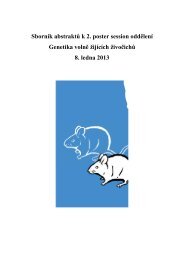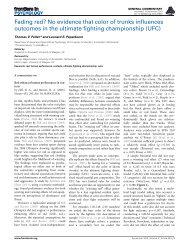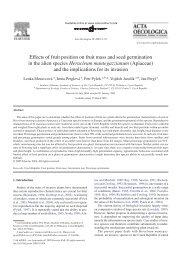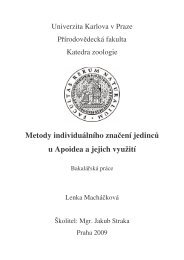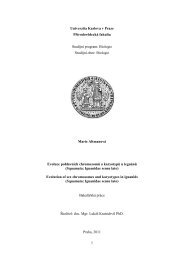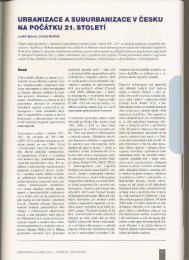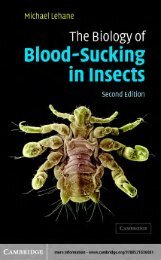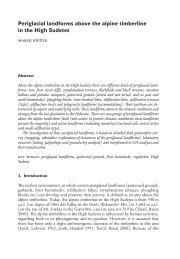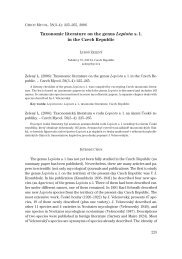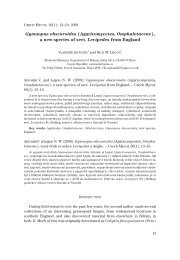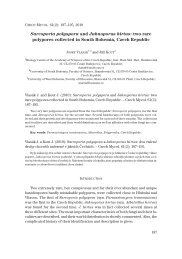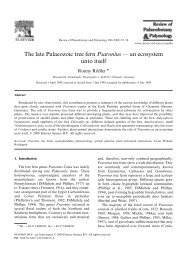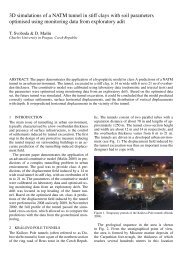vegetation and cultural heritage protection in the state cultural
vegetation and cultural heritage protection in the state cultural
vegetation and cultural heritage protection in the state cultural
You also want an ePaper? Increase the reach of your titles
YUMPU automatically turns print PDFs into web optimized ePapers that Google loves.
VEGETATION AND CULTURAL HERITAGE PROTECTION IN THE STATE<br />
CULTURAL RESERVE OF KERNAV (LITHUANIA)<br />
JRAT SENDŽIKAIT, ROMAS PAKALNIS, DALIA AVIŽIEN<br />
Laboratory of L<strong>and</strong>scape Ecology, Institute of Botany, Žalij Ežer g. 49, LT-08406 Vilnius, Lithuania;<br />
jurate.sendzikaite@botanika.lt, romas.pakalnis@botanika.lt, dalia.aviziene@botanika.lt;<br />
Abstract<br />
The tasks of our research are: to <strong>in</strong>vestigate territorial distribution of plant communities, to evaluate<br />
flora diversity, to <strong>in</strong>ventory redlisted plant species, to assess <strong>the</strong> impact of human activity <strong>and</strong> natural<br />
factors upon <strong>the</strong> development of <strong>the</strong> reserve’s <strong>vegetation</strong> cover as well as suggest optimal ma<strong>in</strong>tenance<br />
<strong>and</strong> exploitation of <strong>the</strong> State Cultural Reserve of Kernav, consider<strong>in</strong>g <strong>the</strong> <strong>in</strong>terests of biodiversity <strong>and</strong><br />
<strong>cultural</strong> <strong>heritage</strong> <strong>protection</strong>. The listed goals are undoubtedly necessary for <strong>the</strong> preparation of<br />
territorial plann<strong>in</strong>g documents as well as selection of optimal models for territorial management,<br />
ma<strong>in</strong>tenance <strong>and</strong> exploitation. The obta<strong>in</strong>ed data on <strong>cultural</strong> <strong>heritage</strong> <strong>and</strong> biodiversity research enabled<br />
us to work out <strong>the</strong> reserve management plan (scheme). Biodiversity assessment enabled <strong>the</strong><br />
researchers to mark out <strong>the</strong> environmental activity priorities: <strong>protection</strong>, restoration, reconstruction<br />
<strong>and</strong> exhibition of plant communities. To determ<strong>in</strong>e territorial zones of <strong>the</strong>se priorities, we considered<br />
<strong>the</strong> pr<strong>in</strong>cipal purposes of <strong>the</strong> whole reserve, <strong>the</strong> regime of <strong>protection</strong> <strong>and</strong> management of <strong>the</strong><br />
immovable <strong>cultural</strong> values <strong>in</strong> separate parts of <strong>the</strong> territory, as well as <strong>the</strong> <strong>state</strong> of plant communities,<br />
<strong>the</strong>ir habitats <strong>and</strong> successions. It was suggested to dist<strong>in</strong>guish 10 zones, accomplish <strong>the</strong>ir mapp<strong>in</strong>g <strong>and</strong><br />
determ<strong>in</strong>e <strong>the</strong> regime of management. This way would permit preservation of <strong>cultural</strong> <strong>and</strong> natural<br />
<strong>heritage</strong>s <strong>and</strong> restore violated elements of l<strong>and</strong>scape <strong>and</strong> its biodiversity.<br />
1. Introduction<br />
The State Cultural Reserve of Kernav is a complex ensemble of archaeological properties,<br />
encompass<strong>in</strong>g <strong>the</strong> town of Kernav, five impressive hill forts, part of an exceptionally large<br />
defence system, some unfortified settlements, <strong>the</strong> traces of ancient l<strong>and</strong> use, burial sites <strong>and</strong><br />
o<strong>the</strong>r archaeological, historical <strong>and</strong> <strong>cultural</strong> monuments from <strong>the</strong> late Palaeolithic period to<br />
<strong>the</strong> Middle Ages. At present, <strong>the</strong> archaeological site displays 18 archaeological, historical <strong>and</strong><br />
<strong>cultural</strong> values <strong>in</strong>cluded <strong>in</strong> <strong>the</strong> Cultural Heritage Register of Lithuania. The State Cultural<br />
Reserve of Kernav (Kernav Archaeological Site; Lithuania) was <strong>in</strong>cluded <strong>in</strong> <strong>the</strong> UNESCO<br />
World Heritage List <strong>in</strong> 2004 (http://whc.unesco.org/en/list/1137). This area represents an<br />
exceptional testimony to <strong>the</strong> evolution of human settlements <strong>in</strong> <strong>the</strong> Baltic region over a period<br />
of some 11 millennia (see fig. 1). The property has exceptional evidence of <strong>the</strong> contact of<br />
Pagan <strong>and</strong> Christian funeral traditions. The settlement patterns <strong>and</strong> <strong>the</strong> impressive hill-forts<br />
represent outst<strong>and</strong><strong>in</strong>g examples of <strong>the</strong> development of such types of structures <strong>and</strong> <strong>the</strong> history<br />
of <strong>the</strong>ir use <strong>in</strong> <strong>the</strong> pre-Christian era.<br />
Consistent archaeological <strong>in</strong>vestigations on <strong>the</strong> area were <strong>in</strong>itiated almost 30 years<br />
ago. Then <strong>in</strong> 1986, irrigation eng<strong>in</strong>eer<strong>in</strong>g workers found rema<strong>in</strong>s of wood road <strong>in</strong> <strong>the</strong> Pajauta<br />
Valley, to <strong>the</strong> south west of Castle hill-fort (Puškorius 2004). In 1989, <strong>the</strong> State Cultural<br />
Reserve of Kernav (194.4 ha) was established <strong>in</strong> order to protect <strong>the</strong> territorial complex of<br />
<strong>cultural</strong> <strong>heritage</strong> objects <strong>and</strong> also to <strong>in</strong>vestigate, supervise, exploit <strong>and</strong> ma<strong>in</strong>ta<strong>in</strong> <strong>the</strong> orig<strong>in</strong>ality<br />
of <strong>the</strong> site. Actually, this reserve has got a status of strict reserve where<strong>in</strong> all farm<strong>in</strong>g<br />
activities, with <strong>the</strong> exception of haymak<strong>in</strong>g, were banned. Kernav is unique not only for <strong>the</strong><br />
richness of <strong>cultural</strong> (particularly archaeological) <strong>heritage</strong>, but also for its impressive natural<br />
complex, which causes wide <strong>in</strong>terest of public. However, <strong>the</strong> data on possibilities of<br />
preservation of natural environment, biodiversity <strong>and</strong> l<strong>and</strong>scape ecoaes<strong>the</strong>tic quality,<br />
consider<strong>in</strong>g <strong>the</strong> <strong>in</strong>terests of <strong>cultural</strong> <strong>heritage</strong> <strong>protection</strong>, are <strong>in</strong>sufficient.<br />
MAN IN THE LANDSCAPE ACROSS FRONTIERS – IGU-LUCC CENTRAL EUROPE CONFERENCE 2007 – PROCEEDINGS 164
Therefore, <strong>the</strong> tasks of our research are: to <strong>in</strong>vestigate territorial distribution of plant<br />
communities, to evaluate flora diversity, to <strong>in</strong>ventory redlisted plant species <strong>and</strong> assess <strong>the</strong><br />
status of populations, to establish <strong>the</strong> prevalence of alien (<strong>in</strong>vasive) plant species <strong>and</strong> describe<br />
<strong>the</strong>ir aggressiveness, to assess <strong>the</strong> impact of human activity <strong>and</strong> natural factors upon <strong>the</strong><br />
development of reserve’s <strong>vegetation</strong> cover, as well as suggest optimal ma<strong>in</strong>tenance <strong>and</strong><br />
exploitation of <strong>the</strong> State Cultural Reserve of Kernav, consider<strong>in</strong>g <strong>the</strong> <strong>in</strong>terests of biodiversity<br />
<strong>and</strong> <strong>cultural</strong> <strong>heritage</strong> <strong>protection</strong>. The above -discussed data are undoubtedly necessary for <strong>the</strong><br />
preparation of territorial plann<strong>in</strong>g documents, as well as selection of optimal modes for<br />
territorial management, ma<strong>in</strong>tenance <strong>and</strong> exploitation. The obta<strong>in</strong>ed data on <strong>cultural</strong> <strong>heritage</strong><br />
<strong>and</strong> biodiversity research enabled us to work out <strong>the</strong> scheme of <strong>the</strong> reserve’s management. On<br />
<strong>the</strong> ground of <strong>the</strong> Convention for <strong>the</strong> <strong>protection</strong> of <strong>the</strong> world <strong>cultural</strong> <strong>and</strong> natural <strong>heritage</strong><br />
(Paris, 1972), not only <strong>the</strong> priorities of <strong>the</strong> <strong>cultural</strong> <strong>heritage</strong> are set <strong>in</strong> <strong>the</strong> scheme, but also <strong>the</strong><br />
ways of <strong>the</strong> <strong>protection</strong>, ma<strong>in</strong>tenance <strong>and</strong> management of <strong>the</strong> whole l<strong>and</strong>scape <strong>and</strong> its separate<br />
components.<br />
Fig. 1 – In 2004, <strong>the</strong> State Cultural Reserve of Kernav was declared a UNESCO World<br />
Heritage Site<br />
Stability of <strong>the</strong> reserve’s <strong>cultural</strong> l<strong>and</strong>scape, <strong>and</strong> preservation of biological diversity<br />
<strong>and</strong> archaeological <strong>cultural</strong> values, are closely related with <strong>the</strong> cognition of natural<br />
environment <strong>and</strong> development of society as well as selection of optimal ways of exploitation<br />
of natural <strong>and</strong> <strong>cultural</strong> objects.<br />
2. Natural conditions<br />
The State Cultural Reserve of Kernav is situated <strong>in</strong> <strong>the</strong> eastern part of Lithuania, on <strong>the</strong> right<br />
bank of <strong>the</strong> River Neris valley (about 35 km northwest of <strong>the</strong> capital, Vilnius). Kernav<br />
represents an area of unique archaeological <strong>and</strong> <strong>cultural</strong> value, as well as a picturesque natural<br />
complex. There are up to one thous<strong>and</strong> hill forts <strong>in</strong> Lithuania, but <strong>the</strong>re is no o<strong>the</strong>r complex of<br />
MAN IN THE LANDSCAPE ACROSS FRONTIERS – IGU-LUCC CENTRAL EUROPE CONFERENCE 2007 – PROCEEDINGS 165
five hill forts along <strong>the</strong> whole region of <strong>the</strong> Baltic Sea. The l<strong>and</strong>scape <strong>in</strong> this region consists<br />
of s<strong>and</strong>y hills <strong>and</strong> results from <strong>the</strong> formations generated dur<strong>in</strong>g <strong>the</strong> retreat of <strong>the</strong> last glacier.<br />
In <strong>the</strong> centre of <strong>the</strong> reserve, at <strong>the</strong> edge of <strong>the</strong> upper terrace, <strong>the</strong>re are four hill-forts<br />
(Pilies kalnas – <strong>the</strong> Castle Hill; Aukuro kalnas – <strong>the</strong> Offer<strong>in</strong>g Hill; M<strong>in</strong>daugo sostas – <strong>the</strong><br />
Throne of M<strong>in</strong>daugas; Lizdeikos kalnas – <strong>the</strong> Lizdeika Hill) st<strong>and</strong><strong>in</strong>g beside each o<strong>the</strong>r. The<br />
fifth hill-fort (Kriveikiškis), distanced eastwards about 0.5 km from <strong>the</strong> ma<strong>in</strong> group,<br />
dom<strong>in</strong>ates <strong>the</strong> cape of <strong>the</strong> terrace created by <strong>the</strong> deep canyon of <strong>the</strong> Kernavel stream. The<br />
Pajauta Valley (valley of <strong>the</strong> River Neris) at <strong>the</strong> foot of <strong>the</strong> hill-forts has preserved <strong>the</strong> <strong>cultural</strong><br />
layer of <strong>the</strong> medieval town of Kernav <strong>in</strong> an area of 25 ha, covered with <strong>the</strong> alluvial deposits<br />
of <strong>the</strong> River Neris. The lowest parts of <strong>the</strong> valley are partly marshl<strong>and</strong>s (see fig. 2). Thanks to<br />
high ground-water deposits by river floods <strong>in</strong> spr<strong>in</strong>g, <strong>the</strong> wooden structures, fences, wooden<br />
pavements <strong>and</strong> household utensils have been preserved, thus contribut<strong>in</strong>g to <strong>the</strong> great<br />
scientific <strong>in</strong>terest of <strong>the</strong> f<strong>in</strong>ds. (Vitknas 1999; Luchtanas 2002;<br />
http://whc.unesco.org/en/list/1137).<br />
Fig. 2 – The Pajauta Valley <strong>and</strong> hill-forts <strong>in</strong> <strong>the</strong> State Cultural Reserve of Kernav<br />
The <strong>cultural</strong> l<strong>and</strong>scape of Kernav developed <strong>in</strong> <strong>the</strong> course of history is a perfect<br />
example of symbiosis between <strong>the</strong> environment formed by natural processes <strong>and</strong> human<br />
activities through centuries. The current reserve’s biological diversity <strong>and</strong> specific features of<br />
flora as well as fauna have been predeterm<strong>in</strong>ed by <strong>the</strong> geomorphological (<strong>the</strong> River Neris<br />
valley with terraces as well as a unique complex of five hill forts) <strong>and</strong> hydrological (spr<strong>in</strong>gy<br />
slopes of hill forts <strong>and</strong> <strong>the</strong> valley, <strong>the</strong> River Neris, <strong>the</strong> rivulet Kernavl) peculiarities,<br />
diversity of soils as well as human activity last<strong>in</strong>g for several thous<strong>and</strong>s of years (particularly<br />
l<strong>and</strong> reclamation of <strong>the</strong> Pajauta Valley <strong>in</strong> 1966–1968 <strong>and</strong> 1985–1986 <strong>and</strong> unjustifiable<br />
plough<strong>in</strong>g <strong>in</strong> 1990s).<br />
MAN IN THE LANDSCAPE ACROSS FRONTIERS – IGU-LUCC CENTRAL EUROPE CONFERENCE 2007 – PROCEEDINGS 166
3. Historical overview of Kernav archaeological site<br />
Many people imag<strong>in</strong>e Kernav as a cradle of Lithuanian <strong>state</strong>hood, with its legends <strong>and</strong><br />
mysterious history. A broad Valley Pajauta, which <strong>the</strong> River Neris w<strong>in</strong>ds through, isles <strong>in</strong> <strong>the</strong><br />
middle of <strong>the</strong> river, mounds with diverse <strong>vegetation</strong> cover create a picturesque l<strong>and</strong>scape,<br />
which attracted our ancestors already 10–11 thous<strong>and</strong> years ago. Accord<strong>in</strong>g to Luchtanas<br />
(2002), hunters of <strong>the</strong> Late Palaeolithic arrived here <strong>in</strong> circa <strong>the</strong> 9 th –8 th millennium BC,<br />
attracted by <strong>the</strong> river rich <strong>in</strong> fish, <strong>and</strong> <strong>the</strong> vast hunt<strong>in</strong>g terra<strong>in</strong> on <strong>the</strong> upper terrace of <strong>the</strong> Neris.<br />
From <strong>the</strong> 1 st to 4 th centuries CE, large settlements were scattered over several kilometres on<br />
<strong>the</strong> banks of Neris <strong>and</strong> <strong>the</strong> Pajauta Valley. Some hills were adapted to defence (<strong>the</strong> Offer<strong>in</strong>g<br />
Hill, <strong>the</strong> Throne of M<strong>in</strong>daugas <strong>and</strong> <strong>the</strong> Lizdeika Hill).<br />
The ancient tribal centre became an important feudal castle at <strong>the</strong> turn of <strong>the</strong> 12 th <strong>and</strong><br />
13 th centuries. In written sources, Kernav was first mentioned <strong>in</strong> 1279 <strong>in</strong> <strong>the</strong> rhymed<br />
Livonian Chronicle (Chronicon Livoniae) <strong>and</strong> <strong>the</strong> Herman Vartberg Chronicle, where it was<br />
described as Traidenis’, <strong>the</strong> Great Duke of Lithuania’s, e<strong>state</strong> (1269–1282). The Medieval<br />
Kernav complex of archaeological sites represents Lithuanian town culture <strong>and</strong> community<br />
<strong>in</strong> <strong>the</strong> 13th–14th centuries. Structurally, it was a formation of <strong>the</strong> European context.<br />
None<strong>the</strong>less, it was unique <strong>in</strong> terms of its <strong>in</strong>ternal, still pagan world <strong>in</strong>tertw<strong>in</strong>ed with <strong>the</strong><br />
Christian culture <strong>and</strong> tradition. The <strong>cultural</strong> <strong>and</strong> religious syncretism stipulated <strong>the</strong> emergence<br />
of <strong>the</strong> exclusive material culture <strong>and</strong> even <strong>the</strong> appearance of specific artefacts, which are<br />
typical only to Kernav (Luchtanas 2002, Vlius 2003).<br />
Kernav was one of <strong>the</strong> most significant economic-political centres of <strong>the</strong> formation of<br />
<strong>the</strong> Lithuanian State as well as a gr<strong>and</strong> ducal residence – <strong>the</strong> first capital of Lithuania. These<br />
were Kernav’s palmy days. In <strong>the</strong> 13th century, Kernav becomes a town of feudal<br />
craftsmen <strong>and</strong> trades people, spread <strong>in</strong> <strong>the</strong> Pajauta Valley between <strong>the</strong> Neris <strong>and</strong> fortified hill<br />
forts. The residence of a duke was up set on <strong>the</strong> Offer<strong>in</strong>g Hill, while <strong>the</strong> o<strong>the</strong>r hill-forts<br />
performed defensive functions. Accord<strong>in</strong>g to Vlius (2002), historical sources give evidence<br />
that <strong>the</strong> town was of mixed ethnic culture. However, we have no way of determ<strong>in</strong><strong>in</strong>g (not<br />
even <strong>the</strong>oretically) what percentage of Kernav’s community was foreign. Specialised<br />
craftsmen <strong>and</strong> merchants lived <strong>in</strong> <strong>the</strong> lower town <strong>in</strong> <strong>the</strong> Pajauta Valley.<br />
Excavations of <strong>the</strong> lower town have revealed specialised homesteads of craftsmen –<br />
jewellers, bone craftsmen, etc. A network of streets lead<strong>in</strong>g towards <strong>the</strong> Neris was formed <strong>in</strong><br />
<strong>the</strong> town. Each homestead (700–900 m 2 ) was surrounded by high fences <strong>and</strong> conta<strong>in</strong>ed<br />
several build<strong>in</strong>gs: a dwell<strong>in</strong>g house <strong>and</strong> two or three workshops. Kernav was an important<br />
feudal town <strong>in</strong> <strong>the</strong> Middle Ages. In 1390, it was attacked <strong>and</strong> deva<strong>state</strong>d by <strong>the</strong> Teutonic<br />
Order. Much of <strong>the</strong> site was ab<strong>and</strong>oned at <strong>the</strong> end of <strong>the</strong> 14 th century, <strong>and</strong> it was covered with<br />
alluvial layers of soil, which protected it. The town <strong>and</strong> <strong>the</strong> castles were never rebuilt, people<br />
moved out from <strong>the</strong> Pajauta Valley <strong>and</strong> started settl<strong>in</strong>g on <strong>the</strong> upper terrace, <strong>in</strong> <strong>the</strong> present<br />
territory of <strong>the</strong> settlement (Luchtanas 2002; Vlius 2003; http://whc.unesco.org/en/list/1137).<br />
Today, celebrations <strong>and</strong> festivals of folklore take place <strong>in</strong> Kernav every summer.<br />
Pagan worshippers celebrate <strong>the</strong> summer solstice on Kernav’s hill forts on <strong>the</strong> shortest night<br />
of <strong>the</strong> year (June 23). Dur<strong>in</strong>g <strong>the</strong> Days of Liv<strong>in</strong>g Archaeology (July), <strong>the</strong> artists <strong>and</strong> masters<br />
of old crafts dress up <strong>in</strong> <strong>the</strong> garb of centuries past <strong>and</strong> put <strong>the</strong>ir creativity on display (see<br />
fig. 2). The festival presents prehistoric crafts, <strong>in</strong>clud<strong>in</strong>g <strong>the</strong> mak<strong>in</strong>g of ancient ceramics, fl<strong>in</strong>t,<br />
amber <strong>and</strong> neolithic amulets, <strong>and</strong> sp<strong>in</strong>n<strong>in</strong>g <strong>and</strong> weav<strong>in</strong>g. It also presents crafts from <strong>the</strong> early<br />
Middle Ages, such as jewellery, m<strong>in</strong>t<strong>in</strong>g <strong>and</strong> weaponry. Visitors can try out dishes of ancient<br />
cuis<strong>in</strong>e, model a pot, try <strong>the</strong>ir h<strong>and</strong> at archery, make a co<strong>in</strong> us<strong>in</strong>g a hammer, listen to archaic<br />
music or take an unforgettable ride <strong>in</strong> a horse <strong>and</strong> cart.<br />
MAN IN THE LANDSCAPE ACROSS FRONTIERS – IGU-LUCC CENTRAL EUROPE CONFERENCE 2007 – PROCEEDINGS 167
4. Methods<br />
Consecutive archaeological <strong>in</strong>vestigations of Kernav environs have been carried out for three<br />
decades. However, <strong>the</strong> obta<strong>in</strong>ed data on biological (plant communities, flora <strong>and</strong> fauna)<br />
diversity of <strong>the</strong> protected area are still <strong>in</strong>sufficient. The <strong>in</strong>vestigations on biological diversity<br />
of <strong>the</strong> State Cultural Reserve of Kernav were <strong>in</strong>itiated <strong>in</strong> 2006, aim<strong>in</strong>g to assess <strong>the</strong> impact<br />
of human activity <strong>and</strong> natural factors upon <strong>the</strong> development of reserve’s <strong>vegetation</strong> cover, to<br />
work out recommendations for exploitation of <strong>the</strong> reserve’s territory <strong>and</strong> to consider <strong>the</strong><br />
possibilities for preservation of biological diversity <strong>and</strong> <strong>cultural</strong> <strong>heritage</strong>.<br />
The aim of <strong>the</strong> research is to <strong>in</strong>vestigate biological diversity <strong>and</strong> plant communities of<br />
<strong>the</strong> State Cultural Reserve of Kernav, <strong>in</strong>ventory protected plant species as well as suggest<br />
optimal ways of management, ma<strong>in</strong>tenance <strong>and</strong> exploitation of <strong>the</strong> area consider<strong>in</strong>g <strong>the</strong><br />
biological diversity <strong>and</strong> <strong>cultural</strong> <strong>heritage</strong> preservation possibilities. On <strong>the</strong> basis of our<br />
scientific studies, <strong>the</strong> recommendations regard<strong>in</strong>g <strong>the</strong> nature management plan of <strong>the</strong> State<br />
Cultural Reserve of Kernav were worked out. On <strong>the</strong> grounds of environmental activity<br />
priorities <strong>and</strong> nature management plann<strong>in</strong>g methods, <strong>the</strong> recommendations for distribution of<br />
<strong>the</strong> State Cultural Reserve of Kernav <strong>in</strong>to territorial zones were worked out (Convention for<br />
<strong>the</strong> <strong>protection</strong> of <strong>the</strong> world <strong>cultural</strong> <strong>and</strong> natural <strong>heritage</strong> 1972; EUROSITE 1999; Stonius,<br />
Mierauskas 2001).<br />
Nomenclature of plant communities was applied follow<strong>in</strong>g <strong>the</strong> floristicphytosociological<br />
plants classification pr<strong>in</strong>ciples of <strong>the</strong> Zürich-Montpelier school (Braun-<br />
Blanquet 1964; Pott 1995; Dieren 1996; Rašomaviius 1998). Lat<strong>in</strong> names of plants were<br />
presented follow<strong>in</strong>g <strong>the</strong> checklist of Vascular Plants of Lithuania (Gudž<strong>in</strong>skas 1999).<br />
5. Material<br />
The biodiversity of <strong>the</strong> reserve depends upon <strong>the</strong> geomorphological (terraces of <strong>the</strong> River<br />
Neris, <strong>the</strong> valley with hill-forts) <strong>and</strong> hydrological peculiarities, variety of soils <strong>and</strong> human<br />
activity. Different systematic categories of meadow <strong>and</strong> forest communities (characterized by<br />
high diversity of vascular plant species) prevail <strong>in</strong> <strong>the</strong> territory of <strong>the</strong> reserve. In 2006–2007,<br />
an <strong>in</strong>ventory of vascular plant species occurr<strong>in</strong>g <strong>in</strong> <strong>the</strong> State Cultural Reserve of Kernav was<br />
carried out, which enabled <strong>the</strong> researchers to make a prelim<strong>in</strong>ary “List of vascular plants<br />
<strong>in</strong>ventoried <strong>in</strong> <strong>the</strong> State Cultural Reserve of Kernav” <strong>in</strong>clud<strong>in</strong>g 434 vascular plant species.<br />
Dur<strong>in</strong>g <strong>the</strong> research period, 12 vascular plant species of <strong>the</strong> Red Data Book of Lithuania<br />
(Rašomaviius 2007) were <strong>in</strong>ventoried: 2 (V) category – Pulsatila patens (L.) Mill., Dianthus<br />
arenarius L., Alyssum gmel<strong>in</strong>ii Jord., Prunus sp<strong>in</strong>osa L., Gentiana cruciata L., Gladiolus<br />
imbricatus L., Dactylorhiza maculata (L.) Soó, Liparis loeselii (L.) Rich., Epipactis<br />
atrorubens (Hoffm.) Besser; 3 (R) category – Lithospermum offic<strong>in</strong>ale L.; 5 (Rs) category –<br />
Dactylorhiza <strong>in</strong>carnata (L.) Soó <strong>and</strong> Dactylorhiza longifolia (Neuman) Aver.<br />
Biodiversity assessment enabled us to mark out <strong>the</strong> environmental activity priorities:<br />
<strong>protection</strong>, restoration, reconstruction <strong>and</strong> exhibition of plant communities. On <strong>the</strong> basis of<br />
<strong>the</strong> scientific <strong>in</strong>vestigations on biological diversity of <strong>the</strong> State Cultural Reserve of Kernav,<br />
recommendations for nature management plan (plann<strong>in</strong>g scheme) were worked out. It’s aims<br />
are: to ensure <strong>the</strong> variety of l<strong>and</strong>scape territorial units <strong>and</strong> <strong>the</strong>ir components; to preserve <strong>the</strong><br />
habitats of flora <strong>and</strong> fauna species <strong>and</strong> communities; to represent both a unique archaeological<br />
<strong>and</strong> <strong>cultural</strong> <strong>heritage</strong> <strong>and</strong> an impressive natural complex; to ma<strong>in</strong>ta<strong>in</strong> biological diversity, <strong>and</strong><br />
to preserve an object of aes<strong>the</strong>tic admiration.<br />
Consider<strong>in</strong>g <strong>the</strong> characterisation of plant communities as <strong>the</strong> tools for habitat<br />
assessment, <strong>the</strong> evaluation of biodiversity of <strong>the</strong> State Cultural Reserve of Kernav allowed<br />
sett<strong>in</strong>g <strong>the</strong> follow<strong>in</strong>g nature preservation priorities:<br />
MAN IN THE LANDSCAPE ACROSS FRONTIERS – IGU-LUCC CENTRAL EUROPE CONFERENCE 2007 – PROCEEDINGS 168
1. Protection <strong>and</strong> exhibition of plant communities;<br />
2. Restoration of plant communities;<br />
3. Reconstruction of plant communities.<br />
To determ<strong>in</strong>e territorial zones of <strong>the</strong>se priorities, we considered <strong>the</strong> pr<strong>in</strong>cipal purposes<br />
of <strong>the</strong> whole reserve <strong>and</strong> <strong>the</strong> regime of <strong>protection</strong> <strong>and</strong> management of immovable <strong>cultural</strong><br />
values <strong>in</strong> separate parts of <strong>the</strong> territory as well as <strong>the</strong> status of plant communities, <strong>the</strong>ir<br />
habitats <strong>and</strong> <strong>the</strong> future successions. It was suggested to establish 10 zones <strong>and</strong> determ<strong>in</strong>e <strong>the</strong><br />
regime of <strong>the</strong>ir management (see fig. 3). This method would enable preservation of <strong>cultural</strong><br />
<strong>and</strong> natural <strong>heritage</strong> <strong>and</strong> restoration of violated elements of <strong>the</strong> l<strong>and</strong>scape <strong>and</strong> its biodiversity.<br />
Fig. 3 – Scheme of <strong>the</strong> recommended nature management zones <strong>in</strong> <strong>the</strong> State Cultural Reserve<br />
of Kernav<br />
Notes: 1A. The zone of <strong>protection</strong> <strong>and</strong> exhibition of natural forest communities; 1B. The zone of <strong>protection</strong> of<br />
meadow communities on hill forts <strong>and</strong> slopes of <strong>the</strong> River Neris valley; 1C. The zone of <strong>protection</strong> of meadow<br />
communities on <strong>the</strong> River Neris bank strip; 1D. The zone of <strong>protection</strong> of meadows with redlisted plants; 1E. The<br />
zone of ma<strong>in</strong>tenance of meadow communities; 1F. The zone of exhibition of p<strong>in</strong>ewood on <strong>the</strong> River Neris valley;<br />
2A. The zone of fen flora restoration <strong>in</strong> wetl<strong>and</strong>s; 3A. The zone of reconstruction of forest communities; 3B. The<br />
zone of reconstruction of green plantations by roadsides <strong>and</strong> on <strong>the</strong> River Neris bank strip.<br />
5.1 Protection <strong>and</strong> exhibition of plant communities<br />
5.1A. The zone of <strong>protection</strong> <strong>and</strong> exhibition of natural forest communities<br />
The zone <strong>in</strong>cludes two fragments of forest communities: forest communities <strong>in</strong> <strong>the</strong> eastern<br />
part of <strong>the</strong> reserve (<strong>the</strong> valley of <strong>the</strong> rivulet Kernavl) <strong>and</strong> forests <strong>in</strong> <strong>the</strong> nor<strong>the</strong>rn part of<br />
reserve (to <strong>the</strong> south of <strong>the</strong> village Bogoliuba).<br />
In <strong>the</strong> eastern part of <strong>the</strong> reserve, <strong>the</strong> nor<strong>the</strong>rn end of <strong>the</strong> valley of <strong>the</strong> rivulet<br />
Kernavl, which <strong>in</strong>tersects <strong>the</strong> reserve’s territory, Picea abies (L.) H. Karst. forest<br />
dom<strong>in</strong>ates, with <strong>the</strong> elements of broad-leaved forest communities; whereas <strong>in</strong> <strong>the</strong> sou<strong>the</strong>rn<br />
end of <strong>the</strong> valley <strong>and</strong> its upper terrace, broad-leaved forests prevail, with a slight admixture of<br />
conifers. The undergrowth conta<strong>in</strong>s such shrub species as Corylus avellana L., Lonicera<br />
MAN IN THE LANDSCAPE ACROSS FRONTIERS – IGU-LUCC CENTRAL EUROPE CONFERENCE 2007 – PROCEEDINGS 169
xolosteum L., Sorbus aucuparia L., Frangula alnus Mill., Daphne mezereum L., <strong>and</strong> o<strong>the</strong>rs.<br />
Trametes versicolor (L.) Lloyd, Fomitopsis p<strong>in</strong>icola (Sw.) P. Karst. <strong>and</strong> o<strong>the</strong>r species of<br />
Polyporales were found on <strong>the</strong> tree trunks. Susta<strong>in</strong>able forest use should be applied <strong>in</strong> this<br />
zone, avoid<strong>in</strong>g ma<strong>in</strong> fell<strong>in</strong>gs <strong>and</strong> allow<strong>in</strong>g only sanitary cutt<strong>in</strong>gs <strong>and</strong> removal of dead trees.<br />
We recommend to establish <strong>the</strong>re an educational hik<strong>in</strong>g track with picturesque natural<br />
path across <strong>the</strong> valley of <strong>the</strong> rivulet Kernavl towards <strong>the</strong> upper terrace of <strong>the</strong> River Neris<br />
valley. The aim <strong>in</strong> establish<strong>in</strong>g <strong>the</strong> track is to allow visitors to <strong>the</strong> reserve to get acqua<strong>in</strong>ted<br />
with natural forest communities, similar to those <strong>in</strong> which <strong>the</strong> medieval town of Kernav once<br />
was established. Visitors would be able to see <strong>the</strong> restor<strong>in</strong>g rivulet Kernavl <strong>and</strong> <strong>the</strong> activity<br />
of <strong>the</strong> colony of beavers (Castor fiber L.).<br />
To <strong>the</strong> south of <strong>the</strong> village Bogoliuba, <strong>in</strong> coniferous forest communities, occurs a<br />
fragment of mixed forest Tilio-Carp<strong>in</strong>etum betuli Traczyk 1962 with Quercus robur L., Tilia<br />
cordata Mill., P<strong>in</strong>us sylvestris L., Corylus avellana L., etc., correspond<strong>in</strong>g to <strong>the</strong> status of key<br />
forest habitat. A large number of Phalangium ramosum (L.) Poir. was recorded <strong>in</strong> herb cover.<br />
This forest fragment is a ra<strong>the</strong>r rare forest community <strong>in</strong> Lithuania, occurr<strong>in</strong>g <strong>in</strong> <strong>the</strong> nor<strong>the</strong>rn<br />
distribution range of broad-leaved forests. We recommend to apply susta<strong>in</strong>able forest use<br />
regime <strong>the</strong>re.<br />
5.1B. The zone of <strong>protection</strong> of meadow communities on hill forts <strong>and</strong> slopes of <strong>the</strong><br />
River Neris valley.<br />
Herbaceous communities establish<strong>in</strong>g on spr<strong>in</strong>gy slopes of <strong>the</strong> Castle Hill, are ascribed to <strong>the</strong><br />
association Cirsietum rivularis Noviski 1927, which <strong>in</strong>cludes Cirsium rivulare (Jacq.) All.,<br />
Deschampsia cespitosa (L.) P. Beauv., Caltha palustris L., Poa palustris L. <strong>and</strong> o<strong>the</strong>r species.<br />
In Lithuania, <strong>the</strong> above-discussed communities reach <strong>the</strong>ir nor<strong>the</strong>rn distribution boundary <strong>and</strong><br />
are located primarily <strong>in</strong> <strong>the</strong> south; <strong>the</strong>refore, <strong>the</strong>y should be protected.<br />
Ra<strong>the</strong>r rare <strong>in</strong> Lithuania, communities of <strong>the</strong> Ass. Geranio-Anemonetum sylvestris Th.<br />
Müller 1961, <strong>in</strong>clud<strong>in</strong>g Anemone sylvestris L., Peucedanum oreosel<strong>in</strong>um (L.) Moench,<br />
Fragaria viridis (Duchesne) Weston, etc. occur on dry slopes of mounds, particularly those of<br />
sou<strong>the</strong>rn aspect. From <strong>the</strong> st<strong>and</strong>po<strong>in</strong>t of nature <strong>protection</strong>, <strong>the</strong>se communities are very<br />
important, because <strong>the</strong>y are less impacted by human activity.<br />
On high slopes of <strong>the</strong> River Neris valley, calciphilous communities of <strong>the</strong> Ass.<br />
Trifolio-Agrimonietum eupatoriae Th. Müller (1961) 1992, <strong>in</strong>clud<strong>in</strong>g Agrimonia eupatoria L.,<br />
Galium album Mill., Senecio jacobea L., Trifolium medium L., Veronica offic<strong>in</strong>alis L., etc.<br />
occur. The communities perform antierosive function <strong>and</strong> <strong>the</strong>y are regarded as st<strong>and</strong>ards of<br />
meadows <strong>in</strong>significantly impacted by economic activity as well as ecoaes<strong>the</strong>tically attractive<br />
(valuable) dur<strong>in</strong>g <strong>in</strong>tensive bloom<strong>in</strong>g. The communities are spread all over Lithuania on <strong>the</strong><br />
edges of deciduous <strong>and</strong> mixed forests <strong>and</strong> sometimes at <strong>the</strong> foot of slopes.<br />
The steep slopes of hill-forts are subject to erosion; <strong>the</strong>refore <strong>the</strong>y should be<br />
monitored <strong>and</strong> controlled. Gradual establishment of tree <strong>and</strong> shrub species, which grow over<br />
unique features of hill forts, might h<strong>in</strong>der preservation of <strong>the</strong> diversity of meadow<br />
communities <strong>and</strong> herbaceous species. We recommend to cut out young trees <strong>and</strong> shrubs<br />
grow<strong>in</strong>g on <strong>the</strong> slopes of hill forts <strong>and</strong> leave only some mature trees as an important element<br />
of history <strong>and</strong> scenery. It is necessary to hay herb cover at least once per <strong>in</strong>tensive <strong>vegetation</strong><br />
season by remov<strong>in</strong>g woody plant shoots <strong>and</strong> protect from grass fires <strong>in</strong> dry season.<br />
MAN IN THE LANDSCAPE ACROSS FRONTIERS – IGU-LUCC CENTRAL EUROPE CONFERENCE 2007 – PROCEEDINGS 170
5.1C. The zone of <strong>protection</strong> of meadow communities on <strong>the</strong> River Neris bank strip.<br />
A narrow belt of herbaceous <strong>vegetation</strong> was marked out on <strong>the</strong> slope of sou<strong>the</strong>rn exposition of<br />
<strong>the</strong> River Neris bank strip on which occur xero<strong>the</strong>rmophilous relict steppe type meadow<br />
communities (Ass. Pulsatillo-Phleetum phleoidis Passarge 1959), which are characterized by<br />
<strong>the</strong> abundant <strong>and</strong> constant Phleum phleoides (L.) H. Karst. <strong>and</strong> less frequent Pulsatilla<br />
pratensis (L.) Mill., Potentilla argentea L., P. arenaria Borkh. Quite abundant populations of<br />
Red Data Book species Dianthus arenarius L. <strong>and</strong> Alyssum gmel<strong>in</strong>ii Jord. (2 (V) category)<br />
were found on some fragments of <strong>the</strong>se dry slopes. In Lithuania, <strong>the</strong>se occasional, small area<br />
cover<strong>in</strong>g meadows are particularly valuable, because <strong>the</strong>y relate <strong>the</strong> present Lithuanian<br />
<strong>vegetation</strong> (flora) with <strong>the</strong> communities which existed <strong>in</strong> <strong>the</strong> past <strong>and</strong> with <strong>the</strong> <strong>vegetation</strong><br />
common to <strong>the</strong> south of our country. The communities should be protected from trampl<strong>in</strong>g,<br />
<strong>and</strong> yearly hay-mak<strong>in</strong>g is not necessary.<br />
5.1D. The zone of <strong>protection</strong> of meadows with redlisted plants.<br />
Hill forts <strong>and</strong> high slopes of <strong>the</strong> River Neris are particularly rich <strong>in</strong> <strong>the</strong> diversity of vascular<br />
plant species <strong>and</strong> meadow communities. On spr<strong>in</strong>gy slopes <strong>and</strong> at <strong>the</strong> foot of hill forts occur<br />
redlisted species – Dactylorhyza <strong>in</strong>carnata (L.) Soó, D. longifolia (Neuman) Aver.<br />
(5 (Rs) category), D. maculata (L.) Soó (2 (V) category), which belong to <strong>the</strong> Orchidaceae<br />
Juss. family.<br />
On <strong>the</strong> restor<strong>in</strong>g meadow between <strong>the</strong> zone of fen flora restoration <strong>in</strong> wetl<strong>and</strong>s (2A)<br />
<strong>and</strong> <strong>the</strong> slopes of <strong>the</strong> River Neris, <strong>the</strong> redlisted species Gladiolus imbricatus L.<br />
(2 (V) category; see fig. 4) was recorded next to Phalaroides arund<strong>in</strong>acea (L.) Rauschert,<br />
Deschampsia cespitosa (L.) P. Beauv., Filipendula ulmaria (L.) Maxim., Lathyrus pratensis<br />
L., Festuca rubra L., Thalictrum lucidum L., Lychnis flos-cuculi L., Caltha palustris L., etc.<br />
As far as Gladiolus imbricatus is bloom<strong>in</strong>g <strong>in</strong> <strong>the</strong> period of May–July <strong>and</strong> it reproduces both<br />
vegetatively <strong>and</strong> by seeds, we recommend to hay <strong>the</strong> area with <strong>the</strong> redlisted plants only <strong>in</strong> <strong>the</strong><br />
second half of August. The same hay<strong>in</strong>g regime is recommended <strong>in</strong> <strong>the</strong> meadows with<br />
Dactylorhyza habitats.<br />
MAN IN THE LANDSCAPE ACROSS FRONTIERS – IGU-LUCC CENTRAL EUROPE CONFERENCE 2007 – PROCEEDINGS 171
Fig. 4 – Gladiolus imbricatus L. is <strong>in</strong>cluded <strong>in</strong> <strong>the</strong> Red Data Book of Lithuania (2 (V)<br />
category)<br />
5.1E. The zone of ma<strong>in</strong>tenance of meadow communities<br />
On <strong>the</strong> o<strong>the</strong>r part of <strong>the</strong> lower terrace of <strong>the</strong> River Neris valley, overgrown with diverse<br />
meadow communities (from dry to moist <strong>and</strong> wet meadows), haymak<strong>in</strong>g is recommended<br />
twice per growth season (at <strong>the</strong> end of June <strong>and</strong> August), pasturage on a moist part of meadow<br />
should be avoided <strong>and</strong> spontaneous seedl<strong>in</strong>gs of P<strong>in</strong>us sylvestris L. <strong>and</strong> o<strong>the</strong>r trees or shrubs<br />
removed.<br />
5.1F. The zone of exhibition of p<strong>in</strong>ewood on <strong>the</strong> River Neris valley<br />
A natural 100–120 year-old P<strong>in</strong>us sylvestris L. st<strong>and</strong> grow<strong>in</strong>g on <strong>the</strong> eastern part of <strong>the</strong> old<br />
settlement of Kernav on <strong>the</strong> right bank of <strong>the</strong> River Neris <strong>in</strong>creases <strong>the</strong> diversity of<br />
<strong>vegetation</strong> structures <strong>and</strong> ecoaes<strong>the</strong>tic value of l<strong>and</strong>scape.<br />
5.2 Restoration of plant communities<br />
5.2A. The zone of fen flora restoration <strong>in</strong> wetl<strong>and</strong>s<br />
On <strong>the</strong> lower terrace of <strong>the</strong> River Neris valley, between <strong>the</strong> road <strong>and</strong> high slopes of <strong>the</strong> River<br />
Neris valley, with <strong>the</strong> exception of <strong>the</strong> <strong>protection</strong> zone of meadow communities with rare<br />
plants (1D), <strong>the</strong> process of fen plant communities restoration is go<strong>in</strong>g on. Now <strong>in</strong> this area<br />
Carex sp. <strong>and</strong> Phragmites australis (Cav.) Tr<strong>in</strong>. ex Steud. thickets dom<strong>in</strong>ate (see fig. 5). In<br />
<strong>the</strong> future, <strong>the</strong> diversity of plant communities should become richer, <strong>in</strong> case water level<br />
<strong>in</strong>crease tendencies, favourable for <strong>the</strong> <strong>protection</strong> of wooden archaeological <strong>heritage</strong>, would<br />
be susta<strong>in</strong>ed.<br />
MAN IN THE LANDSCAPE ACROSS FRONTIERS – IGU-LUCC CENTRAL EUROPE CONFERENCE 2007 – PROCEEDINGS 172
Fig. 5 – The zone of fen flora restoration <strong>in</strong> wetl<strong>and</strong>s (2A)<br />
5.3 Plant communities reconstruction<br />
5.3A. The zone of reconstruction of forest communities<br />
This zone <strong>in</strong>cludes two fragments of forest communities: <strong>in</strong> <strong>the</strong> north-western end of <strong>the</strong><br />
territory between <strong>the</strong> River Neris <strong>and</strong> <strong>the</strong> boundary of <strong>the</strong> reserve grows a P<strong>in</strong>us sylvestris L.<br />
st<strong>and</strong> of <strong>cultural</strong> orig<strong>in</strong>, with an alien <strong>in</strong>vasive species – Acer negundo L. abundantly<br />
reproduc<strong>in</strong>g by shoots. Selective cutt<strong>in</strong>g of Acer negundo L. trees <strong>and</strong> clear cutt<strong>in</strong>g of<br />
undergrowth of this particularly <strong>in</strong>vasive plant every two years is necessary (see fig. 6). Acer<br />
negundo L. should be removed, because it was <strong>in</strong>troduced <strong>and</strong> became widespread much later<br />
than when <strong>the</strong> town of Kernav prospered.<br />
Ano<strong>the</strong>r small part of <strong>the</strong> territory should also be reconstructed because of 20–30 yearold<br />
P<strong>in</strong>us sylvestris L. st<strong>and</strong> on <strong>the</strong> sou<strong>the</strong>rn slope of <strong>the</strong> River Neris valley to <strong>the</strong> west of <strong>the</strong><br />
hill forts area. In <strong>the</strong> communities of this habitat should dom<strong>in</strong>ate Quercus robur L., which<br />
must be planted <strong>in</strong>stead of removed p<strong>in</strong>e-trees. To form a more stable st<strong>and</strong>, we recommend<br />
to plant Tilia cordata Mill. <strong>and</strong> Acer platanoides L. next to Quercus robur L.<br />
MAN IN THE LANDSCAPE ACROSS FRONTIERS – IGU-LUCC CENTRAL EUROPE CONFERENCE 2007 – PROCEEDINGS 173
Fig. 6 – Acer negundo L. <strong>in</strong>vasion <strong>in</strong> P<strong>in</strong>us sylvestris L. st<strong>and</strong> (3A)<br />
5.3B. The zone of selective cutt<strong>in</strong>gs of forest communities<br />
Selective cutt<strong>in</strong>gs should be carried out <strong>in</strong> P<strong>in</strong>us sylvestris L. st<strong>and</strong>s that are grow<strong>in</strong>g <strong>in</strong> <strong>the</strong><br />
zone of White Hill on <strong>the</strong> right slope of <strong>the</strong> River Neris valley, aim<strong>in</strong>g to reveal <strong>the</strong> hill from<br />
<strong>the</strong> left bank of <strong>the</strong> River Neris as well as to create better growth conditions for herbaceous<br />
species Poetum compressae Kizien 1998, which has established itself on <strong>the</strong> slope <strong>in</strong><br />
fragments. The herb layer is quite poor; plant cover <strong>and</strong> species stability <strong>in</strong> <strong>the</strong> communities<br />
are low. The grassl<strong>and</strong> <strong>in</strong>cludes <strong>the</strong> prevail<strong>in</strong>g species Poa compressa L., as well as Jovibarba<br />
globifera (L.) J. Parn., Onobrychis viciifolia Scop., Trifolium montanum L., Artemisia<br />
campestris L., Sedum acre L., Veronica spicata L., Potentilla arenaria Borkh., Thymus<br />
serpyllum L., etc. The communities perform antierosive function, because <strong>the</strong>y fortify eroded<br />
slopes or those without turfy cover. In <strong>the</strong> communities, <strong>the</strong> redlisted species Alyssum<br />
gmel<strong>in</strong>ii Jord. <strong>and</strong> Epipactis atrorubens (Hoffm.) Besser (2 (V) category) were recorded.<br />
Therefore, it is important not to violate <strong>the</strong>ir habitats <strong>and</strong> preserve necessary ecological<br />
conditions dur<strong>in</strong>g selective cutt<strong>in</strong>gs. Meadow fragments should be protected from trampl<strong>in</strong>g<br />
<strong>and</strong> grass fires <strong>in</strong> dry season; hay<strong>in</strong>g is optional.<br />
5.3C. The zone of reconstruction of green plantations by roadsides <strong>and</strong> on <strong>the</strong> River<br />
Neris bank strip<br />
Acer negundo L. trees, which are grow<strong>in</strong>g along <strong>the</strong> old road, should be gradually replaced (<strong>in</strong><br />
5–10 years) by Acer platanoides L. <strong>and</strong> Tilia cordata Mill. On <strong>the</strong> bank strip of <strong>the</strong> River<br />
Neris, we recommend to plant almost grown up trees of Acer platanoides L., Alnus glut<strong>in</strong>osa<br />
(L.) Gaertn., Salex sp., Betula pendula Roth.<br />
MAN IN THE LANDSCAPE ACROSS FRONTIERS – IGU-LUCC CENTRAL EUROPE CONFERENCE 2007 – PROCEEDINGS 174
6. General conclusions<br />
In 2006–2007, an <strong>in</strong>ventory of vascular plant species occurr<strong>in</strong>g <strong>in</strong> <strong>the</strong> State Cultural Reserve<br />
of Kernav was carried out, which enabled researchers to make a prelim<strong>in</strong>ary “List of<br />
vascular plants <strong>in</strong>ventoried <strong>in</strong> <strong>the</strong> State Cultural Reserve of Kernav” <strong>in</strong>clud<strong>in</strong>g 434 vascular<br />
plant species. Dur<strong>in</strong>g <strong>the</strong> research period, 12 vascular plant species of <strong>the</strong> Red Data Book of<br />
Lithuania (Rašomaviius 2007) were <strong>in</strong>ventoried: 2 (V) category – Pulsatila patens (L.) Mill.,<br />
Dianthus arenarius L., Alyssum gmel<strong>in</strong>ii Jord., Prunus sp<strong>in</strong>osa L., Gentiana cruciata L.,<br />
Gladiolus imbricatus L., Dactylorhiza maculata (L.) Soó, Liparis loeselii (L.) Rich.,<br />
Epipactis atrorubens (Hoffm.) Besser; 3 (R) category – Lithospermum offic<strong>in</strong>ale L.; 5 (Rs)<br />
category – Dactylorhiza <strong>in</strong>carnata (L.) Soó <strong>and</strong> Dactylorhiza longifolia (Neuman) Aver.<br />
Accord<strong>in</strong>g to <strong>the</strong> authors’ recommendations, over 95 % of <strong>the</strong> reserve’s territory<br />
should be assigned preservation priorities aim<strong>in</strong>g for <strong>protection</strong>, exhibition <strong>and</strong> partially<br />
restoration of plant communities. Only small patches of damaged plant communities<br />
consist<strong>in</strong>g of <strong>in</strong>vasive plant species should be reconstructed <strong>in</strong>to reference ecosystem. The<br />
aim of <strong>the</strong> recommendations is to ensure <strong>the</strong> diversity of l<strong>and</strong>scape territorial units <strong>and</strong> <strong>the</strong>ir<br />
components <strong>and</strong> preserve <strong>the</strong> habitats of flora <strong>and</strong> fauna species <strong>and</strong> communities. The<br />
reserve would reflect both a unique archaeological <strong>and</strong> <strong>cultural</strong> <strong>heritage</strong> <strong>and</strong> a picturesque<br />
natural complex, preserv<strong>in</strong>g biological diversity <strong>and</strong> aes<strong>the</strong>tic values of l<strong>and</strong>scape. Diversity<br />
of aes<strong>the</strong>tic resources of l<strong>and</strong>scape of <strong>the</strong> State Cultural Reserve of Kernav depend upon<br />
geomorphological peculiarities, hydrological characteristics, variety of <strong>vegetation</strong> structures,<br />
<strong>and</strong> harmony of anthropogenic objects <strong>in</strong> <strong>the</strong> environment. To achieve better ecoaes<strong>the</strong>tic<br />
quality of l<strong>and</strong>scape, a small-scale ma<strong>in</strong>tenance activity is necessary.<br />
The results of scientific <strong>in</strong>vestigations on biological diversity of <strong>the</strong> State Cultural<br />
Reserve of Kernav were <strong>in</strong>tegrated <strong>in</strong>to <strong>the</strong> pr<strong>in</strong>cipal document of <strong>the</strong> reserve’s territory –<br />
plann<strong>in</strong>g scheme. The scheme was discussed at <strong>the</strong> State Lithuanian Commission for Cultural<br />
Heritage, Širv<strong>in</strong>tai Region Municipality Council, presented to <strong>the</strong> local community <strong>and</strong> it is<br />
becom<strong>in</strong>g a pr<strong>in</strong>cipal document regulat<strong>in</strong>g human activity <strong>in</strong> <strong>the</strong> territory of <strong>the</strong> reserve.<br />
The presented recommendations form <strong>the</strong> basis for <strong>the</strong> nature management plan of <strong>the</strong><br />
State Cultural Reserve of Kernav, tak<strong>in</strong>g <strong>in</strong>to consideration not only <strong>the</strong> need of<br />
implementation of <strong>the</strong> basic function of <strong>the</strong> reserve (preservation of <strong>cultural</strong> <strong>heritage</strong>), but also<br />
<strong>the</strong> measures for <strong>protection</strong> <strong>and</strong> management of natural environment. The recommendations<br />
<strong>in</strong>clude <strong>the</strong> <strong>protection</strong> trends of natural components of <strong>the</strong> reserve’s <strong>cultural</strong> l<strong>and</strong>scape, <strong>the</strong><br />
measures for preservation <strong>and</strong> ma<strong>in</strong>tenance of botanical diversity, <strong>and</strong> <strong>the</strong> priorities of<br />
ma<strong>in</strong>tenance <strong>and</strong> management of natural environment as well as activities of nature<br />
<strong>protection</strong>.<br />
Acknowledgements<br />
The authors wish to express <strong>the</strong>ir gratitude to <strong>the</strong> adm<strong>in</strong>istration of <strong>the</strong> State Cultural Reserve of<br />
Kernav for <strong>the</strong>ir f<strong>in</strong>ancial support. Our cordial thanks go to Dr. Živil Lazdauskait for scientific<br />
consultations <strong>and</strong> assistance dur<strong>in</strong>g field trips. S<strong>in</strong>cere thanks to Mrs. Violeta Ptašekien for her k<strong>in</strong>d<br />
l<strong>in</strong>guistic advice.<br />
MAN IN THE LANDSCAPE ACROSS FRONTIERS – IGU-LUCC CENTRAL EUROPE CONFERENCE 2007 – PROCEEDINGS 175
References<br />
BRAUN-BLANQUET, J. (1964): Pflanzensoziologie. Grundzuge der Vegetationskunde (ed. 3).<br />
Spr<strong>in</strong>ger, Berl<strong>in</strong>-Wien-New York. 865 p.<br />
CONVENTION for <strong>the</strong> <strong>protection</strong> of <strong>the</strong> world <strong>cultural</strong> <strong>and</strong> natural <strong>heritage</strong> (1972).<br />
http://whc.unesco.org/archive/convention-en.pdf<br />
DIERSSEN, K. (1996): Vegetation Nordeuropas. Eugen Uimer Verlog GmbH&Co, Stuttgart. 838 p.<br />
EUROSITE management plann<strong>in</strong>g toolkit (1999). Eurosite Programme <strong>and</strong> Development Office,<br />
Tilburg.<br />
GUDŽINSKAS, Z. (1999): Vascular plants of Lithuania. Institute of Botany Publisher, Vilnius. 212 p.<br />
http://whc.unesco.org/en/list/1137<br />
LUCHTANAS, A. (2002): Kernav, <strong>the</strong> Lithuanian Troy. – In: Brzeziski, W. et al. Kernav –<br />
litewska Troja. Katalog wystawy ze zbiorów Pastwowego muzeum-rezerwatu archeologii i historii w<br />
Kernav, Litwa. Pastwowe Muzeum Archeologiczne w Warszawie, Warszawa, p. 11–33.<br />
POTT, R. (1995). Die Pflanzengesellschaften Deutschl<strong>and</strong>s (ed. 2). Verlag Eugen Ulmer, Stuttgart.<br />
622 p.<br />
PUŠKORIUS, A. (2004): Researches of Pajauta valley <strong>in</strong> Kernav lea<strong>the</strong>r f<strong>in</strong>d<strong>in</strong>g from excavations of<br />
1986. Archaeologia Lituana, no. 5: p. 109–116.<br />
RAŠOMAVIIUS, V. (ed.) (1998): Lietuvos augalija. 1. Pievos. Šviesa Publisher, Kaunas–Vilnius.<br />
270 p.<br />
RAŠOMAVIIUS, V. (ed.) (2007): Red data book of Lithuania. Lutut, Publish<strong>in</strong>g Company,<br />
Kaunas. 800 p.<br />
STONIUS, D., TREINYS, R., MIERAUSKAS, P. (2001): Gamtotvarkos vaidmuo saugant biolog<strong>in</strong><br />
vairov. Daigai Publisher, Vilnius. 88 p.<br />
VLIUS, G. (2003): Kernav town community. – In: Brzeziski, W. et al. Kernav – litewska Troja.<br />
Katalog wystawy ze zbiorów Pastwowego muzeum-rezerwatu archeologii i historii w Kernav,<br />
Litwa. Pastwowe Muzeum Archeologiczne w Warszawie, Warszawa, p. 35–56.<br />
VLIUS, G. (2003): Kernav <strong>in</strong> <strong>the</strong> context of towns of <strong>the</strong> Gr<strong>and</strong> Duchy of Lithuania. Archaeologia<br />
Lituana, no. 4: 161–174.<br />
VITKNAS, J. (1999): Kernav. A guide to Kernav <strong>and</strong> <strong>the</strong> Museum of archaeology <strong>and</strong> history.<br />
Vilnius. 72 p.<br />
MAN IN THE LANDSCAPE ACROSS FRONTIERS – IGU-LUCC CENTRAL EUROPE CONFERENCE 2007 – PROCEEDINGS 176



